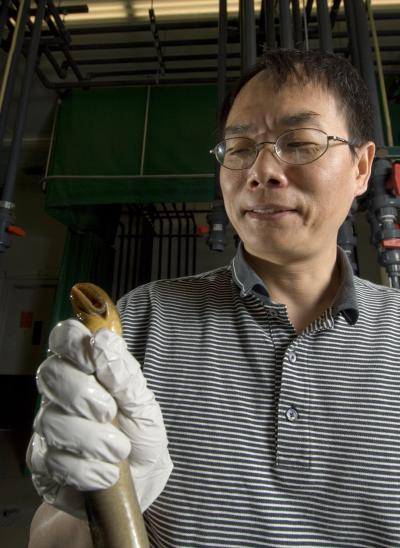MSU at forefront of sea lamprey eradication efforts
Great Lakes Fishery Commission supports new MSU lab to study lamprey biology

For more than two decades, Michigan State University researchers have partnered with the Great Lakes Fishery Commission to support one of the nation’s most successful invasive species control programs – decreasing populations of destructive sea lamprey from catastrophic levels in the 1940s and 1950s to controlled and decreasing numbers today.

GLFC and MSU recently strengthened their partnership through the establishment of a $3.4 million lab under the direction of Weiming Li, a professor in the departments of Fisheries and Wildlife and Physiology supported by MSU AgBioResearch. The project will examine sea lamprey biology and identify genetic modification mechanisms that may allow for further control, or even eradication, of the sea lamprey population in the Great Lakes.
“Our lab is focused on the technical feasibly of genetic biocontrol of sea lamprey,” said Li. “Ultimately, implementation of potential techniques will require many factors to be considered, but our goal is to see how effectively and efficiently we can edit genes and then identify potential gene targets and approaches that we can use to eliminate or drive certain traits or behavior.”
Sea lamprey invasion
Since entering Lake Ontario in the mid-1800s, Lake Erie in 1921, and the upper Great Lakes by the mid-1930s, sea lamprey have inflicted significant economic damage, harmed the fishery and ecosystem, and changed the way of life in the Great Lakes commercial, recreational, and tribal fisheries – today, collectively valued at more than $8 billion annually and supporting more than 75,000 jobs.
Before effective control techniques were implemented starting in 1958, sea lamprey destroyed more than 110 million pounds of fish each year, far more than the commercial catch. Commercial, recreational, and tribal fisheries, and the economies they supported, were devastated. The ecosystem effects of this top-down predator were unprecedented. During the time of highest sea lamprey abundance, up to 85 percent of fish that were not killed by sea lampreys were marked with sea lamprey attack wounds.
“Thanks to a strong commitment to science and research, and through partnerships with institutions like MSU, we’ve developed the tools to bring sea lamprey under control,” said GLFC Executive Secretary Robert Lambe. “The sea lamprey population is down about 95 percent compared to the population before implementation of control methods. No other aquatic invasive species program in the world is as successful at the scale and scope we operate as the sea lamprey control program.”
GLFC’s mission to coordinate and conduct research to control sea lamprey was a natural fit for MSU scientists. The Partnership for Ecosystem Research and Management (PERM) unites MSU researchers with the Michigan Department of Natural Resources (MDNR) and GLFC to address emerging natural resource threats and facilitates MSU’s partnership with GLFC.
“The Great Lakes Fishery Commission is an invaluable partner of MSU AgBioResearch and major supporter of our core mission to conduct research to address current and emerging threats to Michigan’s natural resources,” said MSU AgBioResearch Director George Smith. “The Great Lakes are essential to Michigan’s ecosystem, economy and way of life, and MSU is proud to host this pivotal project that will allow us to better understand and control sea lamprey.”
The significant GLFC investment in MSU’s sea lamprey lab comes as control methods, including lampricides, barriers, traps, and pheromone controls, are showing limitations in their ability to further reduce the sea lamprey population, Lambe said.
“As effective as our control methods are at limiting the growth of the sea lamprey population, it will take something bigger to get to our goal of eradication,” Lambe said.
“This lab is an opportunity for us to explore, through research of the basic biology of sea lamprey, the potential means of controlling the lamprey population through genetic modification,” said Andrew Muir, GLFC Science Director. “Eradication has always been a pipe dream but this offers the opportunity to explore this as an option.”
Weiming Li
Li is a professor and serves as FEJ Fry Chair of Environmental Physiology and a faculty member for the Neuroscience Program and the Ecology, Evolutionary Biology, and Behavior Program.
Li led research teams that discovered pheromones that guide migratory adult sea lamprey to spawning grounds and facilitate reproduction, and pheromone antagonists that disrupt adult sea lampreys as they try to reproduce. He also led a multinational effort to annotate the sea lamprey genome.
In addition to the objective of learning more about sea lamprey biology to assist in control and eradication, examination of the sea lamprey model allows researchers to further understand the origin of vertebrate animals.
“Sea lamprey is a species that draws a lot of interest from the scientific community. Most people who study it do so because it is a model animal to understand evolution and many characteristics of physiology,” Li said.
GLFC operates through the 1954 Convention on Great Lakes Fisheries, and currently facilitates successful cross-border cooperation that ensures Canada and the United States work together to improve the Great Lakes ecosystem.
“We are one of only a few organizations to focus on this species, and our partnership with MSU provides opportunity for us to really push the needle on lamprey research,” Muir said.



 Print
Print Email
Email




